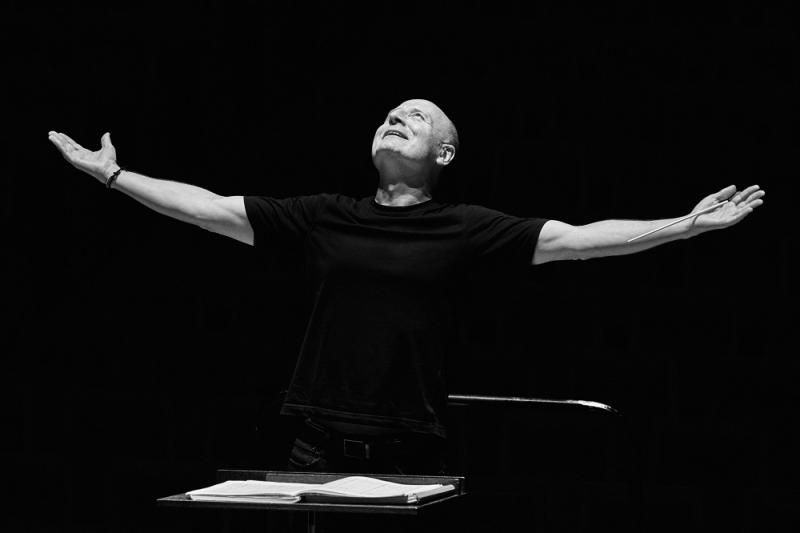Mahler’s Third Symphony, Philharmonia, Paavo Järvi, RFH review - phosphorescent glow, depths only glimpsed | reviews, news & interviews
Mahler’s Third Symphony, Philharmonia, Paavo Järvi, RFH review - phosphorescent glow, depths only glimpsed
Mahler’s Third Symphony, Philharmonia, Paavo Järvi, RFH review - phosphorescent glow, depths only glimpsed
Stylish conducting, classy playing, but no big emotions in the crucial finale

This longest, wackiest and most riskily diverse of Third Symphonies became Esa-Pekka Salonen’s personal property during his years as the Philharmonia's Principal Conductor. His successor, Santtu-Matias Rouvali, has (in)famously said he’s not interested in Mahler. Two of the orchestra’s most distinguished visitors, Jakub Hrůša and Paavo Järvi, certainly are, so after Hrůša’s blazing Second, hopes were high for Järvi’s Third.
It delivered in terms of masterful conducting, effortless in every gear change, and in all those sonorities which must have seemed outrageously novel in 1896; when the playing’s as good as the Philharmonia's, they still have the capacity to surprise. The echo-aftermath of the horns’ big summons at the start was especially startling; Mahler's idiosyncratic take on the May Day marchers who take over from solemn nature sounded brilliant, if kept on the leash (sometimes a touch of apparent out-of-controlness is good). I’d never quite registered the levels of delicate virtuosity required for the second-movement flower picture, so innocuous at the start; the woodland panics of the scherzo could not have been more magically offset by the distant flügelhorn (the programme credited flawless James Fountain as “offstage trumpet”, but whatever the instrument, the sound was exactly right).
 The spell was broken a little by Hogni Wu’s delivery of the Nietzsche text in the midnight song (the mezzo pictured left); several phrases bloomed, but you really need a rock-steady contraltoish tone for the oracular pronouncements, From dark to bright, and the matin bells of the next vocal number had all the cheek Mahler asks for from the excellent Tiffin Boys’ Choir, offset by the classy ladies of the professional Philharmonia Voices.
The spell was broken a little by Hogni Wu’s delivery of the Nietzsche text in the midnight song (the mezzo pictured left); several phrases bloomed, but you really need a rock-steady contraltoish tone for the oracular pronouncements, From dark to bright, and the matin bells of the next vocal number had all the cheek Mahler asks for from the excellent Tiffin Boys’ Choir, offset by the classy ladies of the professional Philharmonia Voices.
Then comes the big test: can the conductor really pull off the finale’s long ascent to the heights? Salonen came to do so over time; the benchmark here will always be Haitink’s absolute naturalness. Perhaps the relationship with the orchestra needs to be a long-term, consistent one to dig deep. This was glowing on the surface, but didn’t move me; there’s a fine line between universal and self love in putting across what Mahler demands here. It’s a tough ask after so much hard work over the previous 75 or so minutes – no surprise if the trumpeters, so good up to the final minutes, sounded less than seraphic in the last haul – and this was no failure. But less, for once, would have been more.
rating
Share this article
The future of Arts Journalism
You can stop theartsdesk.com closing!
We urgently need financing to survive. Our fundraising drive has thus far raised £33,000 but we need to reach £100,000 or we will be forced to close. Please contribute here: https://gofund.me/c3f6033d
And if you can forward this information to anyone who might assist, we’d be grateful.

Subscribe to theartsdesk.com
Thank you for continuing to read our work on theartsdesk.com. For unlimited access to every article in its entirety, including our archive of more than 15,000 pieces, we're asking for £5 per month or £40 per year. We feel it's a very good deal, and hope you do too.
To take a subscription now simply click here.
And if you're looking for that extra gift for a friend or family member, why not treat them to a theartsdesk.com gift subscription?
more Classical music
 Marwood, Crabb, Wigmore Hall review - tangos, laments and an ascending lark
Accordion virtuoso’s brilliant arrangements showcase the possibilities of the instrument
Marwood, Crabb, Wigmore Hall review - tangos, laments and an ascending lark
Accordion virtuoso’s brilliant arrangements showcase the possibilities of the instrument
 Batiashvili, LSO, Pappano, Barbican review - French and Polish narcotics
Szymanowski’s fantasy more vague than Berlioz’s, but both light up the hall
Batiashvili, LSO, Pappano, Barbican review - French and Polish narcotics
Szymanowski’s fantasy more vague than Berlioz’s, but both light up the hall
 Owen, Manchester Camerata, Takács-Nagy, Stoller Hall, Manchester review - more Mozart made in Manchester
Another breath of fresh air in the chamber orchestra’s approach to the classics
Owen, Manchester Camerata, Takács-Nagy, Stoller Hall, Manchester review - more Mozart made in Manchester
Another breath of fresh air in the chamber orchestra’s approach to the classics
 Josefowicz, LSO, Mälkki, Barbican review - two old favourites and one new one
Julia Perry well worth her place alongside Stravinsky and Bartók
Josefowicz, LSO, Mälkki, Barbican review - two old favourites and one new one
Julia Perry well worth her place alongside Stravinsky and Bartók
 Classical CDs: Jelly Babies, porridge and kazoos
German art songs, French piano concertos and entertaining contemporary music
Classical CDs: Jelly Babies, porridge and kazoos
German art songs, French piano concertos and entertaining contemporary music
 Jean-Efflam Bavouzet, Wigmore Hall review - too big a splash in complete Ravel
Panache but little inner serenity in a risky three-part marathon
Jean-Efflam Bavouzet, Wigmore Hall review - too big a splash in complete Ravel
Panache but little inner serenity in a risky three-part marathon
 Karim Said, Leighton House review - adventures from Byrd to Schoenberg
The Jordanian pianist presents a magic carpet of dizzyingly contrasting styles
Karim Said, Leighton House review - adventures from Byrd to Schoenberg
The Jordanian pianist presents a magic carpet of dizzyingly contrasting styles
 Stile Antico, Wigmore Hall review - a glorious birthday celebration
Early music group passes a milestone still at the top of its game
Stile Antico, Wigmore Hall review - a glorious birthday celebration
Early music group passes a milestone still at the top of its game
 Hallé, Elder, Bridgewater Hall, Manchester review - premiere of new Huw Watkins work
Craftsmanship and appeal in this 'Concerto for Orchestra' - and game-playing with genre
Hallé, Elder, Bridgewater Hall, Manchester review - premiere of new Huw Watkins work
Craftsmanship and appeal in this 'Concerto for Orchestra' - and game-playing with genre
 First Person: young cellist Zlatomir Fung on operatic fantasies old and new
Fresh takes on Janáček's 'Jenůfa' and Bizet's 'Carmen' are on the menu
First Person: young cellist Zlatomir Fung on operatic fantasies old and new
Fresh takes on Janáček's 'Jenůfa' and Bizet's 'Carmen' are on the menu
 Classical CDs: Chinese poetry, rollercoasters and old bookshops
Swiss contemporary music, plus two cello albums and a versatile clarinettist remembered
Classical CDs: Chinese poetry, rollercoasters and old bookshops
Swiss contemporary music, plus two cello albums and a versatile clarinettist remembered

Add comment